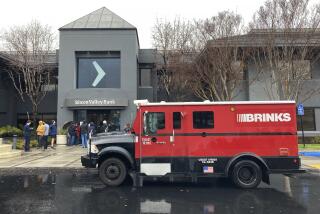Court Widens Damages S&L; Can Recover Over Rule Change
- Share via
WASHINGTON — Savings and loans such as Glendale Federal Bank can recover damages from the U.S. government for potential profits they lost as a result of a 1989 federal accounting rule change, a federal judge ruled Wednesday.
The ruling, by U.S. Federal Claims Court Judge Loren A. Smith, substantially widens the amount of damages the thrifts can recover in dozens of suits against the U.S. government.
The S&Ls;, led by California’s Glendale Federal Bank, say they should be able to recover not only their direct losses from the rule change, but also potential profits they lost because Congress outlawed use of an accounting maneuver known as supervisory goodwill.
Congress’ action wiped billions of dollars worth of paper “capital” off the books of the thrifts, reducing their ability to earn money by making profitable loans.
Glendale is likely to emerge as the biggest winner from Wednesday’s decision. Glendale lost about $565 million in capital from the rule change, and it seeks a total of about $1.5 billion in its lawsuit against the government in compensation for lost business.
Glendale Federal Chief Executive Stephen J. Trafton said in a statement, “We are very pleased with the judge’s decision today and we are ready to present evidence in support of . . . damages.”
Altogether, experts have estimated that the government faces between $10 billion and $20 billion in potential claims in more than 100 separate goodwill lawsuits.
The ability to seek damages for those more indirect losses was thrown into question last July. Only two days after the Supreme Court said Glendale and other thrifts could sue the government, a Washington federal appeals court decision threatened to limit the amount of damages they could seek.
Ruling in an unrelated case, the appeals court said a bank couldn’t recover lost profits in a breach-of-contract claim against the government.
In Wednesday’s decision, Smith said the appeals court ruling didn’t apply in the thrift cases. He said the thrifts “have made a fairly strong logical argument” that they should recover considerably more than the amount of goodwill wiped from their books in 1989.
The judge called the government’s reasoning “circular.” He grilled Justice Department lawyer David Cohen over a key government argument--that the thrifts should have made up for the loss of the goodwill by finding a way to beef up their capital reserves in 1989.
The fight grew out of the government’s 1989 S&L; industry bailout, which enacted sweeping changes in federal regulations for financial institutions.
More to Read
Inside the business of entertainment
The Wide Shot brings you news, analysis and insights on everything from streaming wars to production — and what it all means for the future.
You may occasionally receive promotional content from the Los Angeles Times.










